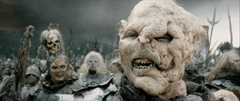Gothmog (Third Age)
| Gothmog | |
|---|---|
| Tolkien's legendarium character | |
| Aliases | Lieutenant of Minas Morgul |
| Book(s) | The Return of the King |
Gothmog is a fictional character from J. R. R. Tolkien's Middle-earth legendarium. He appears briefly in The Return of the King, the third volume of The Lord of the Rings as originally printed.
The only reference to Gothmog in The Lord of the Rings is one sentence in The Return of the King.[1] He served in Sauron's army during the War of the Ring, as the lieutenant of Minas Morgul, second-in-command to the Witch-king of Angmar, lord of the nine Nazgûl (Ringwraiths). He took command of the forces of Morgul during the Battle of the Pelennor Fields after the Witch-king was slain by Éowyn and Merry.[2]
His fate is not described, although Tolkien writes almost all of the servants of Sauron that fought before the gates of Minas Tirith were killed. Tolkien writes nothing else about Gothmog — not even what race of beings he belonged to. In 1971, it was suggested in The Complete Guide to Middle-earth that he was possibly the second highest Ringwraith,[3] but in Unfinished Tales (first published posthumously in 1980), previously unpublished texts by Tolkien provided a different name for that character: Khamûl, "the Black Easterling".[4]
Gothmog shares his name with another of Tolkien's characters, Gothmog Lord of Balrogs, who is featured in The Silmarillion.
In 1988, a new species of Helferella beetles was named Helferella gothmogoides after the character.[5]
Adaptations
In the 1977 SPI board game War of the Ring, Gothmog is described as the second-most powerful Nazgûl and chief lieutenant of Minas Morgul.
In Middle-earth Collectible Card Game by Iron Crown Enterprises Gothmog is depicted as a half-troll, wielding a flail.

In Peter Jackson's The Lord of the Rings: The Return of the King film, Gothmog is portrayed by Lawrence Makoare (who also portrays the Witch-king of Angmar and Lurtz) and voiced by Craig Parker (who also portrays Haldir).[6] Here Gothmog's role is significantly expanded to the point that he is one of the film's main antagonists alongside the aforementioned Witch-king, Sauron, Denethor and Gollum. Gothmog is interpreted as a deformed Orc general with a stunted arm. He prides himself on self-reliance (brushing off a subordinate's offer of help to dismount) and leads courageously from the front-line. Gothmog is a cunning tactician who possesses a cruel sense of humour, evident when he gives orders for trebuchets to release the "prisoners", and when he impales the dying Madril with a spear. According to Peter Jackson, Gothmog's affliction is an elephantiasis-type disease; he dubbed him "the Elephant Man Orc". Jackson asked the Weta Workshop designers to make Gothmog look diseased. Knowing his penchant for outrageous creatures, they piled elephantiasis growths onto a model in such a way that they hoped even he would find it excessive. However, to their surprise, Jackson deemed it to be 'just about right', thus giving Gothmog his "Elephant Man"-type appearance.[7] Jackson's adaptation of Gothmog and Makoare's makeup have been called "the most extreme representation" of the "visual horror" that is created by the general appearance of orcs in the film series.[8]
The extended edition of the film shows his death at the hands of Aragorn and Gimli as he moves to attack the wounded Éowyn.
He is also a playable Mordor hero in Electronic Arts' real-time strategy game The Lord of the Rings: The Battle for Middle-earth II: The Rise of the Witch-king, based on Jackson's films as well as Tolkien's writings; Electronic Arts' The Lord of the Rings: Tactics; in the Evil Mode of Electronic Arts' The Lord of the Rings: The Third Age; in Guardians of Middle-earth,[9] and in the 2nd downloadable upgrade for Lord of the Rings: Conquest. In the Fantasy Flight board game "Middle-earth Quest", he is one of five minions of Sauron. In the 'Lords of Middle Earth' Expansion Pack for the 'War of the Ring' board game he is added as 'minion' of the forces of Sauron.
References
- Notes
- ↑ Tolkien, J. R. R. (1955), The Return of the King, The Lord of the Rings, Boston: Houghton Mifflin (published 1987), "The Battle of the Pelennor Fields", ISBN 0-395-08256-0
- ↑ Foster, p. 117.
- ↑ Foster, p. 184.
- ↑ Tolkien, J. R. R. (1980), Christopher Tolkien, ed., Unfinished Tales, Boston: Houghton Mifflin, Index, entry for Khamûl, ISBN 0-395-29917-9
- ↑ Williams, G. A.; Weir, T. A. (1988). "Further new Species of Australian Mastogeniinae (coleoptera: buprestidae)". Australian Journal of Entomology 27 (3): 179–181. doi:10.1111/j.1440-6055.1988.tb01518.x.
The species name is derived from Gothmog, a commander within the evil host of Mordor, and oides, latin [sic] suffix signifying 'resembling'
- ↑ "Craig Parker interview by SF-Radio". Craig Parker.net. Retrieved 2006-11-06.
- ↑ The Lord of the Rings: The Return of the King Special Extended DVD Edition
- ↑ McLarty, Lianne (2006). "Masculinity, Whiteness, and Social Class in The Lord of the Rings". In Mathijs, Ernest; Pomerance, Murray. From Hobbits to Hollywood: Essays on Peter Jackson's Lord of the Rings. Rodopi Publishers. p. 185. ISBN 9-0420-1682-5.
- ↑ Lien, Tracey (9 November 2012). "Thrain and Gothmog revealed as the newest characters in Guardians of Middle Earth". Polygon. Retrieved 11 December 2012.
- Works cited
- Foster, Robert (1978) [1971]. The Complete Guide to Middle-earth. Random House. ISBN 0-3452-7547-0.